Related Research Articles

Pterodactylus is an extinct genus of pterosaurs. It is thought to contain only a single species, Pterodactylus antiquus, which was the first pterosaur to be named and identified as a flying reptile and one of the first prehistoric reptiles to ever be discovered.
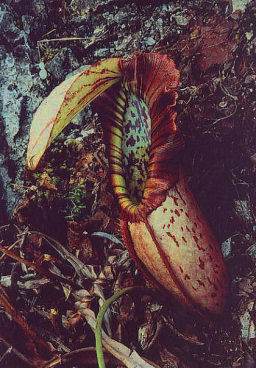
Nepenthes northiana, or Miss North's pitcher-plant, is a tropical pitcher plant endemic to Borneo, where it grows at elevations ranging from 0 to 500 m above sea level. The specific epithet northiana honours the English botanic illustrator Marianne North, who first depicted the species. Nepenthes northiana is one of the most famous Nepenthes, and its discovery in the latter half of the 19th century contributed to Sarawak's reputation as a land of spectacular exotic plants.
Type locality, also called type area, is the locality where a particular rock type, stratigraphic unit or mineral species is first identified. If the stratigraphic unit in a locality is layered, it is called a stratotype, whereas the standard of reference for unlayered rocks is the type locality.

Hypsocormus is an extinct genus of pachycormid fish from the Middle to Late Jurassic of Europe. Fossils have been found in Germany, France and the UK.

Pleurosaurus is an extinct genus of aquatic reptiles belonging to the group Rhynchocephalia, extinct relatives of the modern tuatara. Pleurosaurus fossils have primarily been discovered in the Solnhofen Limestone of Bavaria, Germany and the Canjuers lagerstatte near Canjuers, France, both dating to the Late Jurassic. It contains two species, P. goldfussi and P. ginsburgi.

Gnathosaurus is a genus of ctenochasmatid pterosaur containing two species: G. subulatus, named in 1833 from the Solnhofen Limestone of Germany, and G. macrurus, known from the Purbeck Limestone of the UK. Its fossil remains dated back to the Late Jurassic period.
Californosaurus is an extinct genus of ichthyosaur, an extinct marine reptile, from the Lower Hosselkus Limestone of California, and also the Muschelkalk of Germany.

Crépy is a commune in the Pas-de-Calais department in the Hauts-de-France region of France.
Cleveland Barrens Natural Area Preserve is a 1,288-acre (5.21 km2) Natural Area Preserve located within the Clinch River Valley in Russell County, Virginia.
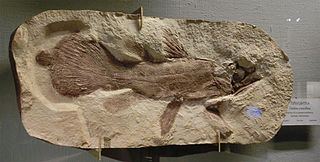
Undina is a genus of prehistoric coelacanth, lobe-finned fish, which lived from the Triassic period to the Cretaceous period.
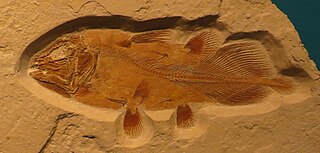
Libys is a genus of coelacanth fish in the family of Latimeridae. Species of Libys lived during the Upper Jurassic period.
Kock's mouse-eared bat is a species of mouse-eared bat found in the Republic of the Congo.

Alligatorellus is an extinct genus of atoposaurid crocodyliform found in France that was related to Atoposaurus.
Neopholidophoropsis is an extinct genus of stem-teleost ray-finned fish that lived in what is now Germany during the Aptian stage of the Early Cretaceous epoch. It contains one species, Neopholidophoropsis serrata.
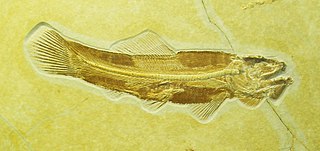
Amiopsis is an extinct genus of prehistoric bony fish belonging to the family Amiidae. Fossils are known from the Late Jurassic Solnhofen Limestone, Germany, the Early Cretaceous Purbeck Group, England, La Pedrera de Rúbies Formation, Spain and Bernnissant Iguanodon locality, Belgium and the Late Cretaceous (Cenomanian) of the Balkans. The monophyly of the genus is questionable, due to it being based on a single character, "the presence of three or more lateral fossae on each side of most abdominal centra". Remains previously assigned to this genus from the Early Cretaceous Las Hoyas, Spain have been moved into the new genus Hispanamia.
Ascalabos is an extinct genus of ray-finned fish known from the Late Jurassic Solnhofen Limestone of Germany. It contains one species, A. voithii.
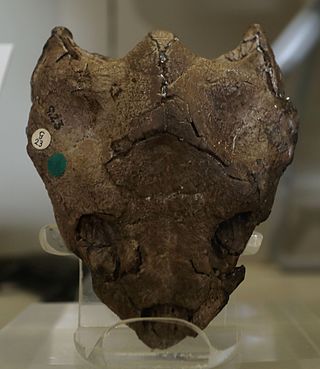
Dorsetochelys is an extinct genus of turtle from the Early Cretaceous of southern England and northwestern Germany.

Koelga is an extinct genus of prawn in the order Decapoda. It contains the species Koelga curvirostris and Koelga muensteri.
Purbeckodon is an extinct genus of mammaliaforms, possibly belonging to Morganucodonta, that is known from Early Cretaceous deposits of southeastern Dorset, England. It was collected in the Purbeck Limestone Group of Dorset. It was first named by Percy M. Butler, Denise Sigogneau-Russell and P. C. Ensom in 2011 and the type species is Purbeckodon batei.

Cancrinos is a genus of fossil crustaceans closely allied with the slipper lobsters. One species is known, C. claviger from the Jurassic of southern Germany.
References
- ↑ Günter Schweigert & Alessandro Garassino (2004). "New genera and species of shrimps (Crustacea: Decapoda: Dendrobranchiata, Caridea) from the Upper Jurassic lithographic limestones of S Germany" (PDF). Stuttgarter Beiträge zur Naturkunde Ser. B. 350: 33 pp.[ permanent dead link ]